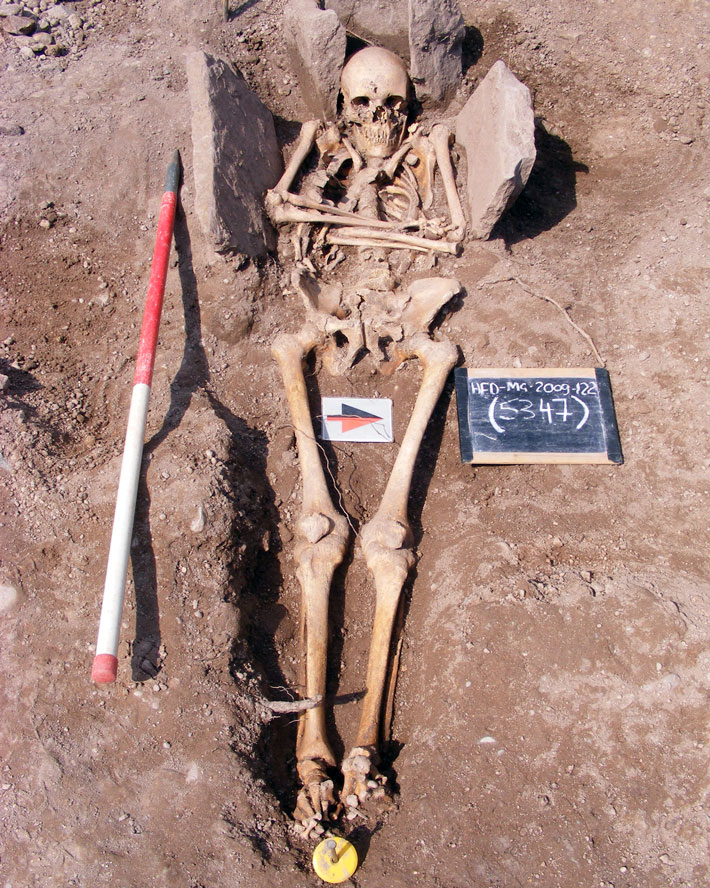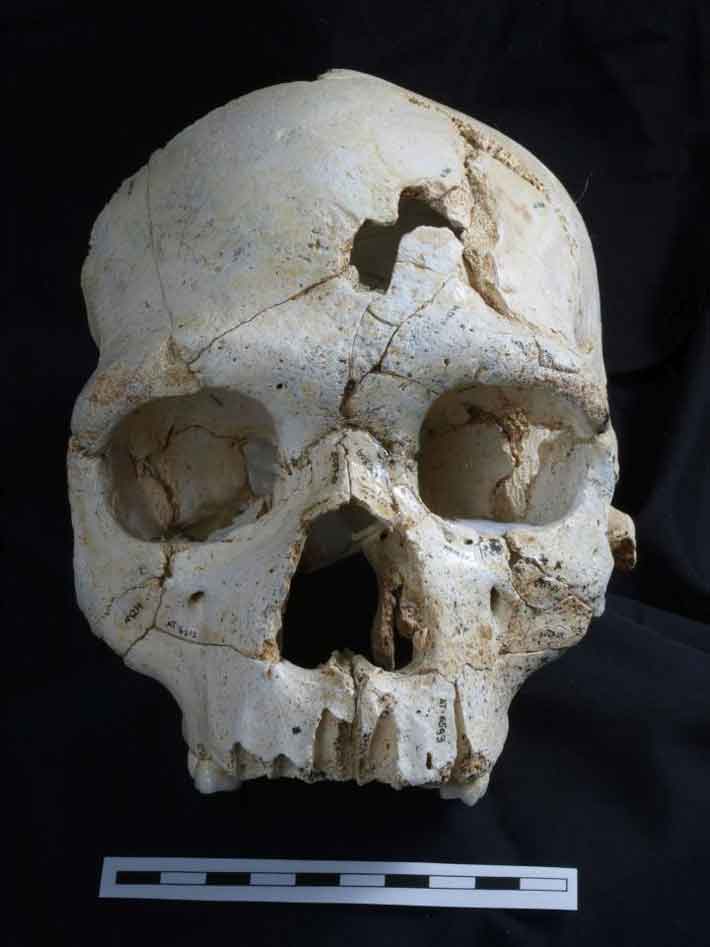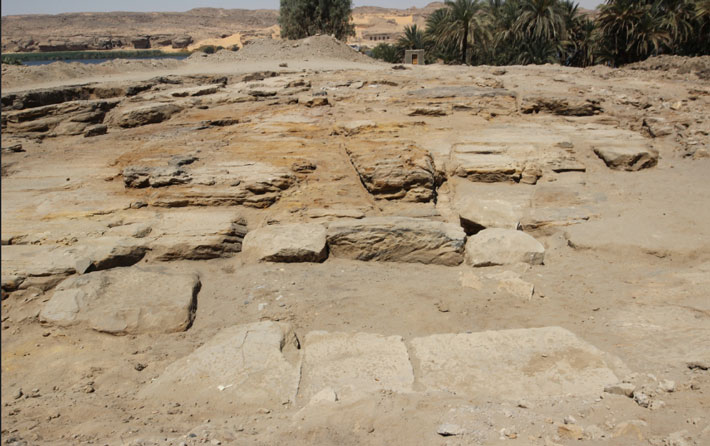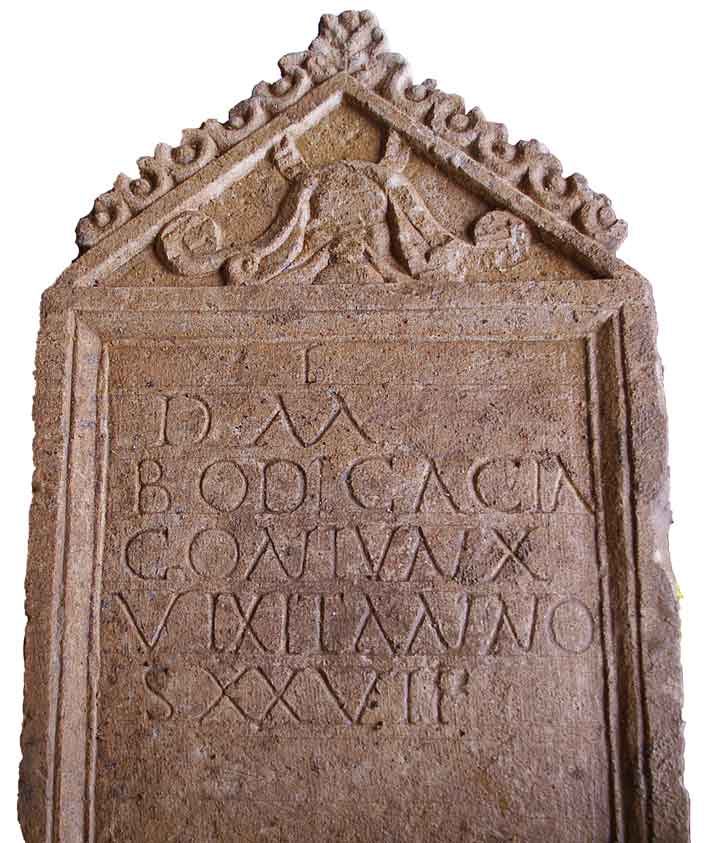From the Trenches
Surely You Joust?
By ERIC A. POWELL
Tuesday, August 11, 2015
 The remains of an injured medieval knight who may have had a serious appetite for jousting have been identified among some 2,500 skeletons unearthed at England’s Hereford Cathedral. The knight immediately stood out because of unusual fractures on the right side of the body. “We were aware of this individual even before he was removed from the ground,” says Headland Archaeology’s Andy Boucher, who supervised the project’s post-excavation analysis. Osteological examination shows that the injuries, including many broken ribs and a shattered shoulder, were the result of blunt force trauma. “In a jousting tourney the knights used blunt weapons,” says Boucher. “If these had been battle wounds, some sharp trauma would be expected.”
The remains of an injured medieval knight who may have had a serious appetite for jousting have been identified among some 2,500 skeletons unearthed at England’s Hereford Cathedral. The knight immediately stood out because of unusual fractures on the right side of the body. “We were aware of this individual even before he was removed from the ground,” says Headland Archaeology’s Andy Boucher, who supervised the project’s post-excavation analysis. Osteological examination shows that the injuries, including many broken ribs and a shattered shoulder, were the result of blunt force trauma. “In a jousting tourney the knights used blunt weapons,” says Boucher. “If these had been battle wounds, some sharp trauma would be expected.”
The identity of the knight remains a mystery, though isotopic analysis of his teeth shows that he was probably born in Normandy and moved to Hereford as an adult. He was about 45 when he died, and not fully recovered from the injuries, suggesting he was still jousting at a relatively advanced age. Once the remains are carbon dated, it may be possible to identify him in contemporary tournament records.
As American as Sliced Bacon in a Can
By SAMIR S. PATEL
Tuesday, August 11, 2015

There’s more to the Salisbury Plain than Stonehenge. Throughout the twentieth century it was utilized as a military training ground, including during World War II, when U.S. forces used the plain as a staging ground for European operations. Over the last few years, archaeologists from Wessex Archaeology have found and excavated the remains of American camps and barracks, and have recently announced some of the finds, including cans of sliced bacon from Chicago (empty, fortunately) and a cache of 16 small cans of New Jersey–made “U.S. Cream Sunburn Preventive” (still creamy).
A Place to Hide the Bodies
By ZACH ZORICH
Tuesday, August 11, 2015
 In northern Spain about 430,000 years ago, the bodies of at least 28 early humans—evolutionary precursors of Neanderthals, Homo heidelbergensis—found their way to the bottom of a 43-foot-deep shaft in the bedrock that archaeologists call Sima de los Huesos, or “Pit of the Bones.” How the bodies got there is a mystery that Nohemi Sala, a paleoanthropologist at the Joint Center for Evolution and Human Behavior at the Institute of Health Carlos III in Madrid, has been trying to solve since 2007. Several explanations have been proposed: Carnivores might have dragged them there, or perhaps 28 separate hapless hominins accidentally fell down the shaft. In one particular case, the pit appears to have been used to dispose of the earliest known murder victim.
In northern Spain about 430,000 years ago, the bodies of at least 28 early humans—evolutionary precursors of Neanderthals, Homo heidelbergensis—found their way to the bottom of a 43-foot-deep shaft in the bedrock that archaeologists call Sima de los Huesos, or “Pit of the Bones.” How the bodies got there is a mystery that Nohemi Sala, a paleoanthropologist at the Joint Center for Evolution and Human Behavior at the Institute of Health Carlos III in Madrid, has been trying to solve since 2007. Several explanations have been proposed: Carnivores might have dragged them there, or perhaps 28 separate hapless hominins accidentally fell down the shaft. In one particular case, the pit appears to have been used to dispose of the earliest known murder victim.
Sala discovered the evidence of murder while studying breakage patterns of the bones—6,700 in total. Most breaks had occurred over the millennia that the bones sat in the ground, but one skull had some very distinctive damage. Two breaks in the forehead appear to have occurred while the individual was alive. With no signs of healing, they indicate the individual did not survive long after being struck. The wounds had been made by a blunt object, and each blow was probably deadly on its own, which rules out the possibility of a hunting accident or unusual suicide attempt.
Sala’s analysis was also important for what it did not reveal. The pit bones did not show much evidence of carnivore damage, or the type of breaks that might occur had people merely fallen in. Sala believes, instead, that Sima de los Huesos was purposefully used to dispose of the deceased, and that it may reflect the capacity of H. heidelbergensis for both violence and compassion. “They cared for the dead,” says Sala, “and this is a very human behavior.”
“T” Marks the Spot
By DANIEL WEISS
Tuesday, August 11, 2015

The remains of a temple at Gebel el-Silsila in southern Egypt were last described in 1934, but were subsequently lost. A map from the early twentieth century, however, marked its general location with a “T.” This spring, using that map, a team led by Maria Nilsson of Sweden’s Lund University uncovered the lost temple’s foundation, which dates back to the fifteenth century B.C. The temple was located at a quarry that provided the building blocks for many of ancient Egypt’s major temples, including Luxor and Karnak. Unexpectedly, and despite the ample supply of sandstone at the quarry, the oldest part of the temple turns out to have been made of limestone. Later construction phases, including those associated with the pharaohs Amenhotep III and Ramesses II, used the local sandstone.
What’s in a Name?
By JARRETT A. LOBELL
Tuesday, August 11, 2015
 What seemed at first to be a simple ancient Roman burial has become an interesting case of how quickly archaeological interpretations can change. In February 2015, archaeologists from Cotswold Archaeology, working on the site of a new parking lot under construction in Cirencester in western England, found a tombstone. Because the site was known to have been a cemetery, the discovery was not especially surprising. But once they had completely excavated it, they found the artifact to be quite unusual. Unlike the other small tombstone fragments found at the site, it was intact, and when they turned it over, they saw that it contained an inscription. Fewer than 300 inscribed tombstones from the period have been found in England.
What seemed at first to be a simple ancient Roman burial has become an interesting case of how quickly archaeological interpretations can change. In February 2015, archaeologists from Cotswold Archaeology, working on the site of a new parking lot under construction in Cirencester in western England, found a tombstone. Because the site was known to have been a cemetery, the discovery was not especially surprising. But once they had completely excavated it, they found the artifact to be quite unusual. Unlike the other small tombstone fragments found at the site, it was intact, and when they turned it over, they saw that it contained an inscription. Fewer than 300 inscribed tombstones from the period have been found in England.
The inscription reads, “In memory of Bodicacia, devoted wife, lived 27 years,” and includes a carved image of the head of a god identified as Oceanus. The discovery got even more exciting when excavators found a skeleton underneath the stone, perhaps an opportunity to identify the buried person, another rarity for the Roman period in England. Upon further examination, however, they found that the skeleton belongs to a man, and that the stone, which dates to between A.D. 125 and 175, was reused perhaps a full two centuries later.
Advertisement
Advertisement
IN THIS ISSUE
Features
Golden House of an Emperor
New York's Original Seaport
Cultural Revival
Letter From England
From the Trenches
Bronze Age Ireland’s Taste in Gold
Off the Grid
A Rare Bird
Atacama’s Decaying Mummies
Bronze Age Traveler
Great Lakes Shipwreck Spotting
Early Parrots in the Southwest
The Red Lady of El Mirón
For the Love of a Noblewoman
Blood on the Ice
Under the Rug
What’s in a Name?
A Place to Hide the Bodies
“T” Marks the Spot
As American as Sliced Bacon in a Can
Surely You Joust?
Artifact
The dragon that guarded Xanadu
Advertisement

Recent Issues
-
 May/June 2024
May/June 2024
-
 March/April 2024
March/April 2024
-
 January/February 2024
January/February 2024
-
 November/December 2023
November/December 2023
-
 September/October 2023
September/October 2023
-
 July/August 2023
July/August 2023
-
 May/June 2023
May/June 2023
-
 March/April 2023
March/April 2023
-
 January/February 2023
January/February 2023
-
 November/December 2022
November/December 2022
-
 September/October 2022
September/October 2022
-
 July/August 2022
July/August 2022
-
 May/June 2022
May/June 2022
-
 March/April 2022
March/April 2022
-
 January/February 2022
January/February 2022
-
 November/December 2021
November/December 2021
-
 September/October 2021
September/October 2021
-
 July/August 2021
July/August 2021
-
 May/June 2021
May/June 2021
-
 March/April 2021
March/April 2021
-
 January/February 2021
January/February 2021
-
 November/December 2020
November/December 2020
-
 September/October 2020
September/October 2020
-
 July/August 2020
July/August 2020
-
 May/June 2020
May/June 2020
-
 March/April 2020
March/April 2020
-
 January/February 2020
January/February 2020
-
 November/December 2019
November/December 2019
-
 September/October 2019
September/October 2019
-
 July/August 2019
July/August 2019
-
 May/June 2019
May/June 2019
-
 March/April 2019
March/April 2019
-
 January/February 2019
January/February 2019
-
 November/December 2018
November/December 2018
-
 September/October 2018
September/October 2018
-
 July/August 2018
July/August 2018
-
 May/June 2018
May/June 2018
-
 March/April 2018
March/April 2018
-
 January/February 2018
January/February 2018
-
 November/December 2017
November/December 2017
-
 September/October 2017
September/October 2017
-
 July/August 2017
July/August 2017
-
 May/June 2017
May/June 2017
-
 March/April 2017
March/April 2017
-
 January/February 2017
January/February 2017
-
 November/December 2016
November/December 2016
-
 September/October 2016
September/October 2016
-
 July/August 2016
July/August 2016
-
 May/June 2016
May/June 2016
-
 March/April 2016
March/April 2016
-
 January/February 2016
January/February 2016
-
 November/December 2015
November/December 2015
-
 September/October 2015
September/October 2015
-
 July/August 2015
July/August 2015
-
 May/June 2015
May/June 2015
-
 March/April 2015
March/April 2015
-
 January/February 2015
January/February 2015
-
 November/December 2014
November/December 2014
-
 September/October 2014
September/October 2014
-
 July/August 2014
July/August 2014
-
 May/June 2014
May/June 2014
-
 March/April 2014
March/April 2014
-
 January/February 2014
January/February 2014
-
 November/December 2013
November/December 2013
-
 September/October 2013
September/October 2013
-
 July/August 2013
July/August 2013
-
 May/June 2013
May/June 2013
-
 March/April 2013
March/April 2013
-
 January/February 2013
January/February 2013
-
 November/December 2012
November/December 2012
-
 September/October 2012
September/October 2012
-
 July/August 2012
July/August 2012
-
 May/June 2012
May/June 2012
-
 March/April 2012
March/April 2012
-
 January/February 2012
January/February 2012
-
 November/December 2011
November/December 2011
-
 September/October 2011
September/October 2011
-
 July/August 2011
July/August 2011
-
 May/June 2011
May/June 2011
-
 March/April 2011
March/April 2011
-
 January/February 2011
January/February 2011
Advertisement






